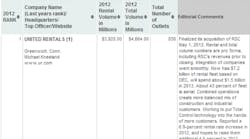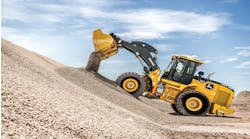RER 100: Top Rental Equipment Companies of 2012 Article: A Very Good Year
No doubt Frank Sinatra had other things in mind besides improved physical and dollar utilization, increased rental rates and higher rental volume when he sang that famous song, but it was a very good year for the RER 100. Not every company posted improved numbers, but the majority certainly did.
See the 2013 RER 100 list here.
Among companies that reported rental volume this year and last, or posted them publicly, the average increase was about 16 percent in rental volume, and most of the companies interviewed for this story said they had imprved EBITDA, rental rates and utilization. After several years of reduced capex for fleet, the majority were buying more, replacing their fleet, and reducing fleet age.
The overall RER 100 total increased 15.4 percent to $13.967 billion, the largest total RER 100 rental volume in the history of the listing, topping 2007 by about $114 million. Last year’s No. 100 company, All Star Rents, posted $8.7 million in rental volume; this year company No. 100 — Illini Hi Reach — posted $10.6 million. Noble Iron reported rental volume of $10.5 million but had to be content with being No. 101. Yes there were some new listees, but also several that dropped off, including RSC, Pioneer Rentals and Topp Portable Air that were acquired.
All-Time Record
The rental volume of this year’s RER 100 is an all-time high, topping the previous record, set in 2007, by $113.7 million, less than 1 percent. (The figures only include Nos. 1-100, they do not include those of the “RER 100” Extras”.)
The top 10 of the RER 100 increased 15.4 percent in rental volume in 2012. Its total of $8.93 billion was the highest since the peak year of 2007 and the third highest total in the listing’s history.
The RER 100’s Top 10
The Top 10 of the RER 100 increased 15.4 percent in rental volume in 2012. Its total of $8.930 billion was the highest since the peak year of 2007 and the third-highest total in the listing’s history.
For the most part, RER 100 executives are happy with the progress their companies made in 2012.
“I believe, like most everyone, that improved utilization and rental rates helped a lot,” says Bob Kendall of Star Rentals (No. 54), echoing a number of RER 100 leaders. “The overall improvement in non-residential construction contributed significantly and the further broadening of our customer base (industrial, institutional, and governmental) also contributed measurably.”
“Our pro-forma adjusted EBITDA margin for the year was 42.6 percent, which was 650 basis points higher than in 2011,” says Michael Kneeland of industry pace-setter United Rentals. “It was driven up by margin improvements in all of our major revenue streams.”
Many companies enjoyed the improved revenue and increased demand, but weren’t about to break out the champagne bottles just yet as rental rate pressure is still a serious concern, exacerbated by the failure of flat or slightly increasing rental rates to keep up with increasing original equipment costs, primarily as a result of Tier 4 interim engines. And the rental industry knows all too well that Tier 4 final emissions standards are right around the corner.
A common opinion is that with rental rates slow to improve, rental companies will be forced to raise them by increased costs.
“We did see improvements in 2012 and expect that with increased costs from tier emissions, rates will be forced upwards to meet ROI targets,” says Marty Hardin of B&G Equipment & Supply (No. 67).
While most RER 100 executives agree that passing on increased equipment costs to their customers is necessary, they also contend that it’s easier said than done, and that incremental rental rate increases of 5 or 8 percent won’t make up for equipment costs likely to multiple two or three times that much. So while they may be unable to make up the difference in rates, they know they will have to make it up, to a degree, with efficiencies.
“Equipment margins have not increased due to double-digit price increases from manufacturers but our cost measurement processes are starting to pay off in reduced downtime, service calls, and major component failure,” says Glen Townsend, vice president and general manager of Kirby Smith Machinery (No. 27).
What has become clearer to many RER 100 executives is the need to monitor rates more proactively and given better software and management tools, it’s easier to do that than in the past.
“We monitor time and dollar utilization very closely at each branch and for each asset class, and adjust fleet size accordingly on an ongoing basis,” says Tom Moilanen, Cloverdale Equipment Rental (No. 88).
“We’ve had an incredible focus on getting rates up,” adds Kendall. “We are running reports every single week on where we’re at on rates and then benchmarking those against where we are on utilization. As utilization improves, the rates should be improving right along with it.”
One of the encouraging developments in 2012 was that some companies were beginning, in some cases tentatively, to expand again, either by hiring additional sales staff, opening a new branch or two, spending more on fleet and looking to enhance marketing efforts, usually through Internet advertising or social media efforts. While many are still cautious in their spending, not wanting to fall in the same traps that came close to crippling them in 2007-8, they are, nonetheless, viewing their marketplaces more aggressively than in previous years. Some, such as Ecco Equipment (No. 73) say they are spending as much as one third of their rental revenue on fleet expenditures.
Centers of Power
What states/provinces are headquarters to the most RER 100 companies?
What cities are headquarters to the most RER 100 companies (suburbs included)?
A common theme expressed by RER 100 executives is that customers are renting more and buying less. Some attribute that to the overall secular shift, while others say simply that contractors, just like everybody else, are filled with uncertainty and either lack capital or are reluctant to invest it.
“In 2012 contractors were renting more than purchasing for all their equipment needs,” says Jerry Zagami, Clairemont Equipment, San Diego (No. 78). “Most contractors in California do not have enough backlog to purchase new equipment.”
The overall outlook for 2013 is more optimistic than has been expressed in the industry since before the recent recession, with many, such as United’s Kneeland, saying that industry conditions are likely to improve in 2013 and accelerate in 2014 and 2015.
Most companies report a strong start to 2013.
“We are up 9 percent over 2012 for the first quarter,” says Keith Olson, Colorado Machinery (No. 87). “We are projecting up 7 percent for 2013 over 2012, so we are a little ahead. It’s a real strong rental market.”
“2013 is starting off very strong with rental revenue in the first quarter increasing 22 percent from existing operations,” adds Mike Winemiller, president of Briggs Equipment (No. 24).
Strong start to 2013
“We see utilization trending upward over 2012 thus far, and we have added more fleet at each of our branches to accommodate,” says Joel Theros, Theros Equipment (No. 91). “Several key contractors that we deal with in the marketplace have cited that they have a lot more bid-work than they have had in the last couple of years.”
It may take a year or more to put 2012 in its proper perspective. As stated, for the most part, for most RER 100 companies, it was a good year. If the upward trend continues and the economy accelerates during the next few years as many expect, it may simply be seen as the beginning of an even stronger upward trend. However the next few years shake out, compared to the ditch the industry is emerging from, that’s a welcome relief. rer







